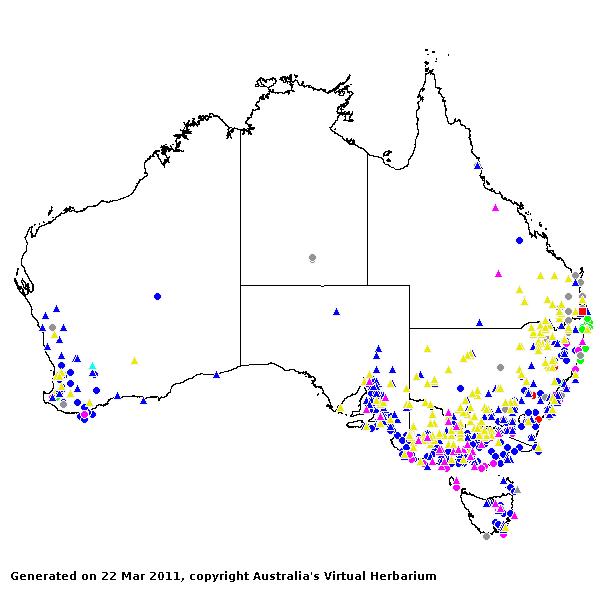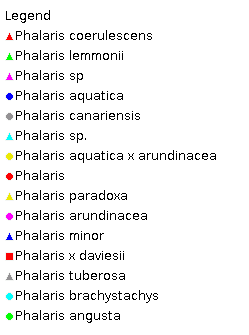Phalaris* Sp .Pl. 54 (1753).
Derivation:. From Greek phalos, the ridge of a helmet, descriptive of the winged glumes.
Taxonomic revisions, nomenclatural references:. D.E.Anderson, Iowa State J. Sci. 36: 1–96 (1961).
Key references (keys and floras):. G.Bentham, Flora Australiensis 7: 556–557 (1878); C.A.Gardner, Flora of Western Australia 1 Gramineae 22–26 (1952); J.W.Vickery, Flora of New South Wales, Gramineae 19: 283–293 (1975); J.C.Tothill and J.B.Hacker, Grasses Southern Qld 342–344 (1983); J.P.Jessop, Flora of South Australia 4: 1913–1914 (1986); B.K.Simon, Key to Australian Grasses 144 (1993); S.W.L.Jacobs and S.M.Hastings, Flora of New South Wales 4: 635–637 (1993); N.G.Walsh, Flora of Victoria 2: 464–467 (1994); D.I.Morris, Student's Flora of Tasmania 4B: 250–253 (1994); E.Edgar and H.E.Connor, Flora of New Zealand 5: 351–355 (2000); D.Sharp and B.K.Simon, AusGrass (2002); J.P.Jessop, Grasses of South Australia 238–244 (2006); S.W.L.Jacobs, R.D.B.Whalley & D.J.B.Wheeler, Grasses of New South Wales, 4th ed, 336–339 (2008); A.Wilson (ed.), Flora of Australia 44A: Poaceae 2: 145–152 (2009).
W.D.Clayton & S.A.Renvoize, Genera Graminum (1986), genus (196).
Naturalised. 16 species, from north temperate regions, South America. 7 species in Australia, WA, SA, Qld, NSW, Vic, and Tas. Also Malesia and New Zealand.
Habit. Annual or perennial, rhizomatous or tufted or decumbent. Leaf blades broad or narrow. Ligule an unfringed membrane.
Inflorescence. Inflorescence a false spike, with spikelets on contracted axes or paniculate, a spike-like panicle, open (rarely) or contracted. Spikelet-bearing axes when disarticulating, falling entire (the clusters falling in P. paradoxa and P. caerulescens).
Spikelets. Spikelets more than 2 flowered, with 1 fertile floret, solitary or several in a whorl (?), pedicelled; with rachilla terminating in a floret. Fertile spikelets with lower incomplete floret(s) (2 florets), strongly laterally compressed, disarticulating above glumes or falling with glumes or not disarticulating.
Glumes. Glumes more or less equal, about equal to spikelet to exceeding florets, long relative to adjacent lemmas, pointed, awnless, keeled, with keel conspicuously winged or without a median keel-wing, similar (papery). Lower glume 1–5 nerved. Upper glume 1–5 nerved.
Florets. Lower incomplete floret(s) usually sterile. Lemmas awnless, exceeded by fertile lemmas, less firm than fertile lemmas (reduced to scales), not becoming indurated. Fertile florets 1. Lemmas decidedly firmer than glumes, becoming indurated, entire at apex, pointed, muticous, 5 nerved, hairy or glabrous, 1 keeled. Palea relatively long, entire to apically notched, textured like lemma, indurated or not indurated, 1 nerved or 2 nerved, not keeled. Lodicules 2. Stamens 3. Grain small, compressed laterally. Hilum long-linear. Embryo large (up to a third of the grain length) or small.
Kranz Anatomy. C3.
2n = 12, 14, 28, 35, 42, and 56 (and aneuploids), 2, 4, 6, and 8 ploid (and aneuploids), commonly adventive.
Habitat. Helophytic, mesophytic. In weedy places, damp soils and swamps. Species of open habitats.
Classification. Pooideae; Poeae.
Types Species. P. canariensis L.
Biogeographic Element. Clifford & Simon 1981, Simon & Jacobs 1990: Naturalised.


